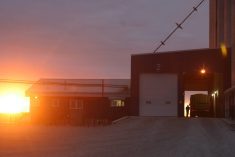Jan Layh has become a passionate advocate of artistic life in rural
Saskatchewan since she moved to Langenburg from Saskatoon in 1994.
She calls the eastern border town of 1,300 a “hopping place” and lists
the art classes she teaches from her gallery, the new bed-and-breakfast
business in town, the mural painted on the local theatre and the
singing groups. At one time Langenburg was the smallest town in Canada
to have a barbershop quartet chapter.
She said the healthy cultural community is partly the influence of the
Read Also

Producer profits remain under significant pressure
Manitoba farmers are facing down a double hit of high input costs, like fertilizer, and low grain prices as they harvest their next crop.
Organization of Saskatchewan Arts Councils. Layh, who volunteers as the
local OSAC representative, said the performers and art shows that tour
rural Saskatchewan expose people to experiences they wouldn’t get
unless they drove to the city.
“A lot of kids would never go to an art gallery.”
Funded by government and lottery money, OSAC forms a unique link
between artists and performers and 50 arts council members and 75
school centres.
It organizes concerts and art shows that tour places ranging in size
from Kincaid, the smallest at 190 people, to Yorkton, the largest at
16,747. OSAC estimates one in 10 people in Saskatchewan saw one of its
exhibitions or performances last year.
“Because it’s all Saskatchewan artists, that makes coming to see the
art more interesting,” Layh said. “People support it. People appreciate
it.”
Langenburg’s thriving arts scene also draws people from Manitoba who do
not have a similar organization to broker rural events.
The concerts and art shows are also integral to the success of the
Rosthern Station Arts Centre, said Cathy Thiessen, the council rep in
Rosthern.
The 12-year-old centre commissions its own summer plays and serves as
the stage for OSAC’s winter events.
While known singers like Garnet Rogers and fiddler April Verch can draw
big audiences, the concert mix of unknown talent and classical music
also helps new performers create audiences, she said.
Rosthern’s concert series has been sold out each of the last five
years. Thiessen said about a third of the audience is new every year.
That’s partly because the concerts and art shows are a bargain. The
price is the same in each community and block booking means savings can
be passed on in admission prices.
Marguerite Gallaway of Estevan helped found OSAC in 1968 and served as
its first executive director. Still volunteering with her local arts
council, she is convinced that people in rural Saskatchewan have as
much right to see quality entertainment as city dwellers. As well, “it
fills a market for our artists.”
Dennis Garreck, OSAC’s executive director, said the group’s success
depends on volunteers in the small towns and communities, which means
it is affected as the rural population ages and shrinks. Volunteers are
busier than ever, filling the gaps for several organizations.
There is also other competition for people’s leisure time, such as TV
and computers.
“People don’t have to go outside their home to get entertained.”
Audience numbers for the concerts are not declining significantly,
although Garreck said arts councils still have to do a good sales job,
which means doing more than putting up a poster.
Selling a series is better than individual events, Garreck said,
because then a specific concert night is not ruined because of a
blizzard or a competing hockey game.
While OSAC takes ideas from its member councils about what performers
they would like to see, it also holds a showcase at its annual
conference. This provides a taste of 15 acts available for touring,
pared from an audition list of 75.
“We can’t afford to bring in big names, but we bring a good quality and
variety at affordable prices.”
OSAC also uses adjudication panels to help decide which artists’ art
goes on tour.
“We end up curating it, creating it and crating it for two-year tours.”
















